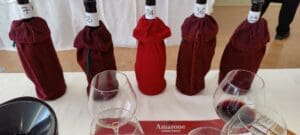I thank you if I have been missed. Having just came back from an intensive month of studying, I admit that one should not expect sympathy because none will be shown to people who chose to embark on the Society of Wine Educators’ (SWE) Certified Wine Educator (CWE) program. I asked for it, I went for it, and I am done with it. At least for now, until I received the results. So what in the world is this CWE program that took me away from the surface of the world and left my site orphaned?
For more than one year I have been involved in the coaching of Certified Specialist of Wine (CSW) candidates in Singapore, initially part-time and now on a full-time basis. Most people are benefiting from the specialist title, and I also noticed how the CSW program has opened doors for many graduates in career-switching and advancement. As for the Certified Wine Educator certification, it is one level higher than my existing CSW. Why the heck would I need this?
Well, presenting information to people in a way that not just show domain expertise as a trade professional, but also as an educator for audiences from all levels is quite similar to what I am doing. I took the examination to assess my proficiency to write and share, and of course in the long run to improve my credibility to my audiences. I have heard many who argued there is no demand for such a qualification, but remember, Steve Jobs created iPhone at a time where there’s no need for it.
Today there are close to 360 people worldwide who have been awarded this title. More than 80 percent attained only after repeated attempts, a testament to the difficulty of the wine educator’s certification.
The process of being certified comprises of five parts, with four parts to be performed in one day. The first is an one hour paper with 85 multiple choice questions. Sounds easy? Not quite. The questions expect a thorough understanding of more than one topic and it can draw upon knowledge from wine terms, styles and regions before deciding an answer. An example can be like, “the Malaga Crianza wine from Italy is made using Vermentino, fortified after fermentation and aged for 12 months.”
That example is wrong in many ways. But if you are in the trade, you get the idea.
If one only has enough time to cover one book, then that should be Exploring Wines. The book published by the Culinary Institute of America was a life-saver for the multiple choice exam. The old world chapters, in particular, were written with such depth that it should be labelled as the authoritative book for exam preparation. The only downside is the copy I have was published in 2010, a little outdated but nothing the internet cannot compensate with. Personally, this was the toughest hurdle to clear.
Second part is an essay that needs microscopic details yet simple enough, explaining all the technical terms, so that readers can learn from it. Writing MLF instead of Malolactic Fermentation is a no-no since only people in the trade are familiar with the term. Again, this calls for deep understanding of the subject. Topics on grapes and wine styles are one of the easiest ways to start preparing for the examination. The current sample topic provided on SWE portal is to compare the style of Malbec in New World and Old World. However since the essay will only be marked if the multiple choice exam is a pass, failing the first part means I will never know if my essay makes the cut.
The last two parts revolve around tastings. First set is a varieties identification test that consists of four white and four red wines, and we need to correctly identify at least six out of a list of ten wines. Seemingly easy, but the proctor will, with certainty, prepare wines with similar styles from different regions. The basic things to consider are the variety expression, followed by the region and the vintage. One thing I learned during the examination, Northern Coast is not a sole representation of California. How naive of me.
The second tasting is to correctly identify the problems in at least six out of eight wines, seven were off-balance and one unaltered among them. Heighten levels of alcohol, sugar, acidity, sulphur dioxide, tannins, oxidation and acescence (smelling like vinegar) must be correctly picked up. Since there are only eight wines for eight options, the minimum score deducted for mistake is two points. Very small margin for errors. Some of these can be detected instantly by smelling, while others may need tasting to tell the differences. This is the second most challenging segment, especially after a long stressful day.
Now is it possible to make up for a poorly performed segment with an outstanding scores from the other three? Nope, a minimum score of 75 percent must be achieved in all segments to pass the examination. Remember, this is a wine educator’s exam, not a tennis game.
Right now I am keeping my fingers crossed while waiting for the results. Since the essay part will need grading from three examiners, the longer it takes to receive the result translates to better odds of passing. The fifth and last segment, is a presentation, which I can’t comment until it happens.
I hope it happens.



